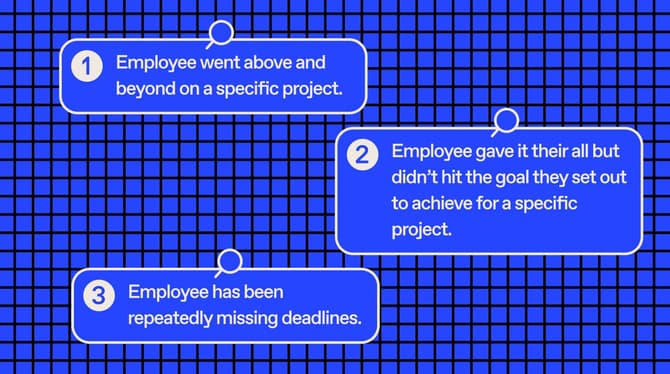Upholding diversity and supporting your employees are two vital pillars of a healthy workplace. However, supporting diversity requires a genuine deep dive into the employee experience to uncover problem areas. A great way to see how your people are feeling is by sending out diversity, equity, inclusion, and belonging (DEIB) surveys.
Read on to learn how you can incorporate DEIB surveys into your day-to-day to create a positive and thriving corporate culture.
Exclusive online summit
·
May 23 2024
Moments that matter: how to seed great work
What's in this article
What are DEIB employee surveys?
DEIB stands for diversity, equity, inclusion, and belonging: the four pillars of building strong teams that support an organization's success. A DEIB survey — sometimes referred to simply as a diversity and inclusion survey — aims to collect data and insights on your organization's employee experience by looking at the reality of different demographics.
Understand the 11 pillars of employee experience to build an EX strategy tailored to your diverse workforce.
Diversity, equity, and inclusion survey questions usually involve a mix of multiple-choice, rating, and open-ended questions for feedback on your organization's practices.
Let's recap these key components:
- Diversity: Diversity in the workplace means recognizing and celebrating differences across your employees — be it gender, race, ethnicity, religion, sexual orientation, disability, or age. When you measure diversity in the workplace and create actionable efforts to improve it, employees will feel safer and more welcome. Implementing recruitment strategies that actively reach and invite a candidate pool of diverse social and cultural backgrounds is a great way to bring diversity to the forefront of company culture.
- Equity: Equity in the workplace refers to providing employees with fair opportunities and resources they require to flourish in their careers. Everyone has different needs, so equity is about tailoring programs and other support initiatives to individuals. Think mentorship programs with specially identified mentors, or flexible work arrangements for employees who need to work around certain home-life circumstances.
- Inclusion: Inclusion encompasses whether employees feel respected and valued among their peers and managers, examining how at ease your employees feel in the workplace.To foster a more inclusive environment, organizations can hold bonding activities or host interactive workshops that promote honest conversations to consider diverse perspectives.
- Belonging: Belonging is the emotional aspect of DEI initiatives. Employees should feel comfortable and accepted as they are in the workplace. Belonging is crucial to cultivating a space that is truly inclusive for all. Acknowledgment and recognition go a long way — from birthdays to personal milestones to cultural observances, there are many opportunities in the calendar year to create shared celebrations. Gender-neutral bathrooms, breastfeeding rooms, or prayer areas are also ways to foster belongingness in the office.
Asking the right diversity, equity, and inclusion survey questions — why it matters
Companies leverage the insights of DEIB questions to measure current policies and weed out areas that need improvement. If you ask pointed questions, you can only access a true, holistic view of your workplace environment to measure diversity, equity, and inclusion.
They help managers overcome obstacles
Diversity and inclusion surveys help managers gain more helpful results, which leads to more responsive action. Vague survey questions warrant unhelpful responses, but targeted queries focusing on employee sentiment and experience will help you measure inclusion and boost diversity.
Workleap Officevibe data found that 37% of employees don't feel close to their managers — highlighting the fact that a disconnect between leaders and their teams is not uncommon. Without diversity and inclusion surveys, managers might not even be aware of diversity and inclusion issues, unconscious biases, or other inclusion gaps.
They uncover industry-specific issues
While many DEIB practices can apply to all cases, creating an inclusive work environment also has its industry-specific challenges. As a manager, you're deeply connected to your field and might not recognize the widespread diversity and inclusion issues within your industry.
Researchers Paul J. Hickey and Qingbin Cui found that female and LGBTQ employees in construction and engineering fields suffer striking workplace discrimination rates within traditionally male-dominated industries. Male or heteronormative managers may not be aware of this since they do not experience the same reality.
25 DEIB survey questions to make your own
Here, find diversity, equity, and inclusion survey questions to use as examples. Personalize them so they align with your own company's needs and goals.
Diversity questions
Diversity questions like these aim to assess and enhance the diverse richness of your workplace environment. Personalize these questions to align with your company's unique context:
1. Do you think our company has a diverse workforce?
You might stare at numbers and percentages all day and think your workforce boasts decent diversity. However, this means little if your employees disagree. Sometimes straightforward questions offer the most transparent and helpful results.
2. On a scale from 1 to 10, how well does our company promote an inclusive environment regardless of sexual orientation, race, age, nationality, or disability status?
Using a rating system or a check-all-that-apply response for this question can help you identify which groups your company should work harder on including.
3. Do you think our company considers job applications from diverse groups equally?
The people a company hires are a crucial indicator of its diversity and inclusion status. Ask your employees about their experiences with the hiring process and whether or not they felt it honors diversity.
4. Do you feel valued for the work you complete, regardless of your sexual identity, race, disability, or nationality?
You might have a variety of people making up your workforce, but that doesn't mean your company treats each person the same, whether intentionally or unintentionally. Learning who does or doesn't feel appreciated or valued for their skills at work can help you discover where you might need to increase recognition efforts.
5. Do you ever feel unconscious biases within our workplace culture?
Sometimes coworkers, bosses, or business community members might unintentionally circulate biased and prejudicial opinions. Uncovering subtle diverse microaggressions helps reveal what goes on behind the scenes.
6. Have you ever felt uncomfortable discussing your race, nationality, gender identity, or disability with anyone at work?
Everyone should feel comfortable and confident talking about who they are, and that extends to the workplace. Of course, conversations at the office should stay professional, but it's important to connect with your peers on a human level for interpersonal support.
7. Do you have ideas on how our management might improve the diversity and inclusion of our workplace culture?
Open-ended, idea-based questions are remarkable opportunities for improvement. Your employees are the bedrock of your organization and will help you identify any diversity issues they may be facing, and will likely have ideas on how to resolve them.
Equity questions
Equity survey questions focus on unearthing possibly unnoticed inequalities within the workplace. Asking direct questions often helps you discover which employees experience unfair treatment and how you can address those issues:
8. Do managers offer equal opportunities to people of all different backgrounds?
Managers offer opportunities to their employees in many ways, like selecting who will present a sales pitch, dedicating a new client to a certain employee, or picking someone as their go-to associate. Use this survey question to gauge whether or not your workforce perceives that your management allocates opportunities equally.
9. Does our company's career progression system offer equitable opportunities for career growth among all employees?
While everyone's professional trajectories and ambitions take different shapes, companies should offer equitable opportunities for all employees and offer incentives to boost employee engagement like promotions, raises, and bonuses. Ask your team this question to ensure that you're promoting employees fairly.
10. Do you think everyone gets treated fairly within our organization?
Sometimes, asking straightforward questions can help you receive the best survey results. You could use an open-ended answer for employees to discuss how they feel about fairness or offer a rating scale to gather quantifiable data on equity.
💡 We recommend leaving this survey question anonymous so that employees feel at ease answering transparently.
11. Have you ever noticed favoritism in the workplace? If so, how did it happen?
Favoritism is a privilege and comes in many forms; most managers often don't realize they're doing it. Maybe you tend to pick the same people repeatedly for the most sought-after tasks or never consider certain people for projects with big payoffs. Other team members are likely to be aware of this, hence why diverse opinions matter.
12. Does your management team support disabled employees' needs?
Equity requires supplying each person with the tools they need to succeed, regardless of who they are and what abilities or disadvantages they might have. Providing differently-abled persons on your team with the necessary support creates a more accessible and equitable work environment.
13. Does management practice transparent communication for everyone regarding pay, promotions, and opportunities?
Each manager practices transparency and communication differently. Regardless of your preferred methods, you want to ensure that everyone receives the same information. Use this question to determine the perceptions of how well your managers communicate with everyone on their teams.
14. How can we improve our equity efforts?
Just like at the end of the diversity survey, we recommend offering an open-ended box where employees can offer ideas on possible and suggested equity improvements.
Inclusion questions
Inclusion survey questions aim to uncover how people feel about the company's entire environment, including their peers, managers, workload, projects, meetings, discussions, and more. Personalize your inclusion survey questions to assess current policies or initiatives.
15. Does the senior leadership team prioritize inclusion initiatives?
Managers must take action on employee feedback surveys to show their commitment to change. Even if you don't think your organization has diversity and inclusion challenges, employees will still expect you to make constant positive strides toward improvement. Use this question to learn whether or not your team thinks your management prioritizes diversity and inclusion.
16. Do you feel comfortable sharing your opinions and ideas with coworkers and managers, even if they differ?
Feeling included means feeling comfortable enough to join conversations. Often, when someone feels shunned because of their race, gender, sexuality, or other identifying factors, it signifies an inadequate level of diversity and inclusion in the workplace.
💡 You might consider offering an open text box where employees can add names of anyone they specifically don't feel comfortable speaking with to help you discover problem areas.
17. How would you rate our company's inclusive culture on a scale from 1 to 10?
Often, a diversity and inclusion survey provides insight but no measurable results to compare against other metrics in the future. We recommend using a rating scale between 1 and 10 so you can quantify results and see how well any new policies improve diversity and inclusion survey scores.
18. Are you confident in sharing your opinions with management, even when they contradict the "norm?"
Some employees might feel intimidated by their managers, especially if they hold a contrary opinion. Certain groups may feel less inclined to share their thoughts out of fear of retribution or discrimination.
19. Has anyone at work discriminated against you because of your race, ethnicity, religion, political beliefs, or cultural background?
The main goal of this question is to uncover discrimination in any possible area of the workplace. Discriminatory actions could include comments from other coworkers, clients, customers, interns, or any other stakeholder.
20. Do you have ideas on how we could introduce more inclusion efforts to improve workplace culture?
Again, we recommend closing your diversity and inclusion survey questions with an open-ended, qualitative idea response form. Let your employees offer their ideas and feel heard. You'll likely gather excellent information from their opinions.
21. Did this diversity and inclusion survey feel helpful? If not, what inclusion questions would you like to see next time?
Asking a general question about the survey itself can help improve your questions for the next survey. You may have missed a key question on sexual orientation, or perhaps employees would prefer a different rating scale to answer their questions. Letting your team advise you on future questionnaires can boost survey completion and employee engagement rates.
Belonging questions
Belonging in the workplace is crucial for creating a supportive environment where employees feel accepted and valued. Personalize the following questions to how strongly your employees feel they belong within the company:
22. On a scale from 1 to 10, how included do you feel in team activities and discussions?
Sometimes, asking if an employee feels they belong might be too open-ended. Steering questions towards specific contexts that are linked to belongingness, such as asking about their experience with team activities and discussions, might reveal more insights
23. Have you ever hesitated to express your authentic self at work?
Gauging belongingness is not as straightforward as with other components of DEIB surveys. Think of creative questions that prompt different ways belonging (or lack of) can manifest in employees or present in how they experience work.
24. Are there specific aspects of our workplace culture that you believe contribute positively to a sense of belonging?
To complement employee insights on what could use improvement, include questions that assess what initiatives are working well. This allows decision-makers to assess what DEIB activities are having the most impact, and understand what to invest in more or less of.
25. Do you have suggestions on how we can enhance the overall feeling of belonging for employees?
It's good to use open-ended questions that allow employees to answer how they want. Some might provide a lot of insights, while some might be more reserved. Regardless, some answers may reveal surprising truths when not confined to pre-define multiple-choice answers.
8 tips for boosting employee engagement on your survey
Nudging your employees to take the time out of their day to answer survey questions can be challenging. We recommend using the tips below to boost employee engagement and participation rates across your surveys:
Tip #1. Pick the best questions from our list above and personalize them to your business
Every employee, every team, and every company is unique. Customize your diversity and inclusion surveys so that questions reflect the nuances of your business. You could ask questions about how recent industry trends have impacted employees on a day-to-day, or their opinion on a specific inclusion initiative at work.
Tip #2. Make the survey anonymous
Some topics can feel vulnerable, and anonymity allows employees to freely express themselves. At the end of the day, you want survey answers to be honest, not censored. Leverage the anonymity features of online surveys, which work like a digital anonymous feedback box.
Tip #3. Communicate the survey objectives
Avoiding ambiguity here is key. When you provide context to employees, they can better understand the purpose behind the questions, which might encourage them to invest a little more in their answers. Something as simple as "We are exploring remote work scheme possibilities, and your insights would help us decide what's best collectively" does the job.
Tip #4. Carve out a time so everyone can fill out inclusion surveys
When days get busy, it's hard to find time for non-urgent tasks. DEIB surveys might get bumped back up the pipeline if employees have to prioritize client calls or project deadlines, so make sure you help employees schedule time to complete the survey without stress.
Tip #5. Make all questions optional, so no one feels pressured
Some employees might feel uneasy answering questions — and even more so if it's mandatory. Employees are entitled to privacy, so questions about personal life or sexual orientation should always be optional. Try open-ended questions, which allow employees to choose what aspects they want to answer unnecessary pressure.
Tip #6. Offer multiple response formats
Because people have different communication styles, one-size-fits-all inclusion surveys might not capture everyone's input effectively. Using a variety of response formats, like multiple choice or open-ended text boxes, allows you to collect both quantitative and qualitative data.
Tip #7. Share survey results with your team for transparency
To create a culture of openness, transparency has to go both ways. Just like you include employees in collecting answers, include them in accessing insights, too. This could look like a post-survey recap once all data has been compiled.
Tip #8. Follow up with additional surveys after you introduce new policies
Changes within companies are a never-ending journey. It's all about evolution! After implementing new DEIB policies, use follow-up surveys to gauge their effectiveness. This practice is part of a continuous improvement culture.
Leveraging technology to bring your DEIB efforts together
Creating effective and helpful diversity and inclusion survey questions isn't easy, but there are solutions out there designed to help you navigate the process.
Workleap Officevibe helps build safe channels between employees and management teams with interactive and engaging survey questions, private responses, and powerful data insights with tools that make tracking data easy.
Request a demo to start building more inclusive and healthier workplaces.
Equip HR and managers with tools to engage, recognize, and drive performance.




